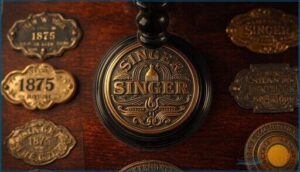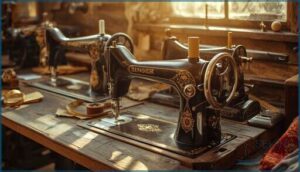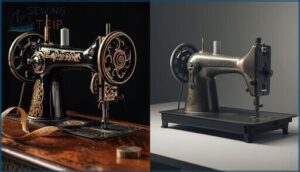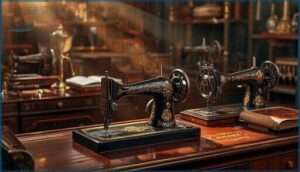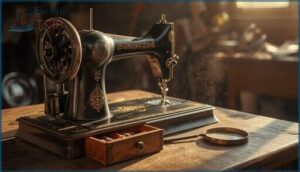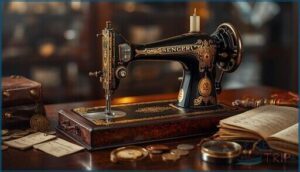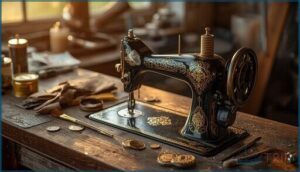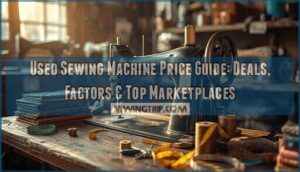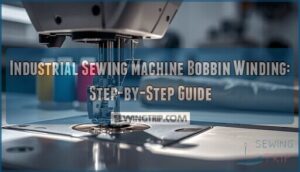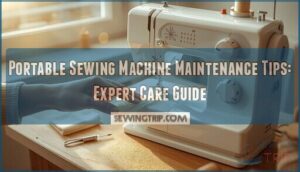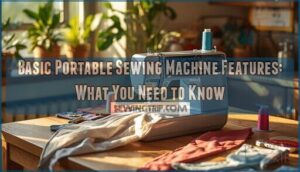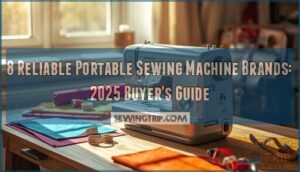This site is supported by our readers. We may earn a commission, at no cost to you, if you purchase through links.
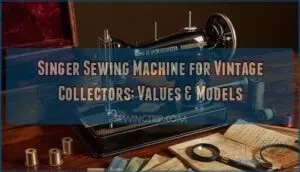
A collector recently paid $2,500 for a Singer Featherweight 221—a machine that originally sold for $125 in 1933. While most vintage Singer machines trade hands for $50 to $500, certain models command prices that rival fine furniture or jewelry.
The difference between a $75 flea market find and a $2,000 treasure often comes down to serial numbers, decal preservation, and knowing which models serious collectors chase. Pre-1950 Singers with chromed steel mechanisms outlast their modern counterparts and appreciate steadily, turning patient collectors into profitable dealers.
Understanding authentication markers, condition grading, and restoration economics separates casual buyers from investors who consistently flip machines for 300% returns.
Table Of Contents
Key Takeaways
- Pre-1950 Singer machines with cast iron construction and chromed steel parts outlast modern counterparts by decades, with 82% remaining operational after 70 years versus 40% of electric models, making them superior long-term investments for collectors who prioritize durability and mechanical reliability.
- The Singer Featherweight 221 dominates the vintage market with prices ranging from $1,000 to $2,800 for restored units, while ultra-rare variants like the 1933 Chicago World’s Fair edition (only 40 known examples) can exceed $2,400, representing the gap between common finds and museum-quality collectibles.
- Serial numbers, trademark badges, and original decal preservation determine whether a vintage Singer sells for $75 or $2,500, with complete sets including original accessories commanding 20-100% higher prices than incomplete machines missing key components like foot pedals or manuals.
- Strategic restoration investments of $50-$300 typically generate 25-150% value increases within 18 months, with restored pre-1940 mechanical models averaging $350 higher resale values and curated platforms like Etsy yielding 27% higher prices than general marketplaces.
Identifying Vintage Singer Models for Collectors
You can’t judge a vintage Singer by looks alone. The key to unlocking a machine’s true identity lies in its serial number, trademark badges, and design details that separate valuable finds from common yard sale models.
Here’s what to look for when you’re hunting down a Singer worth collecting.
Serial Number Dating Methods
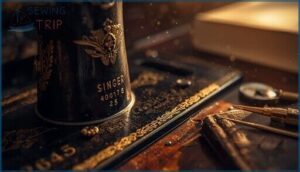
Since Singer stamped serial numbers on every machine starting in 1850, you can pinpoint your model’s age by decoding its location and format. Pre-1950 models show numbers engraved near the handwheel, while post-1950 units place them under the bed or on raised pads.
Dating methods rely on:
- Prefix formats: Post-1900 machines use letter codes (e.g., K88001 from Elizabethport)
- Factory codes: Kilbowie used F, M, P prefixes; Clydebank assigned FA–FY series
- Allocation years: Numbers were assigned to batches, not production dates—check official records
- Dual-serial systems: 1855–1889 machines show both register and factory numbers
- Numeric sequences: Pre-1900 models used digits only, up to eight characters
To determine the age of your Singer sewing machine, you can use the serial number guide to find the exact production year. These identifying marks reveal your Singer sewing machine history.
Trademark Badge Recognition
Once you’ve locked down serial numbers, turn to Singer trademark badges for era identification. These brass plates—riveted to the main pillar—changed every few decades, giving you instant clues about badge history and production windows.
Early badges (1875–1884) read “The Singer Manufacturing Co. New York” with shuttle-and-thread graphic features, while post-1885 versions dropped “New York” but kept the emblem. Centennial badges (1950–1952) add collector value with their yellow-center “A Century of Sewing Service” inscription, and special-edition event badges—like those from the 1933 Chicago World’s Fair—command premium prices among serious collectors hunting rare antique Singer sewing machine value guide markers.
Understanding the sewing machine history is vital for identifying authentic vintage models.
Model-Specific Design Features
Badges reveal era, but each Singer model carries physical fingerprints that separate it from the pack. You’ll spot these design quirks fast once you know what sets the collector-favorite machines apart.
Key model identifiers include:
- Featherweight 221: Aluminum frame keeps weight at 11 pounds—three times lighter than cast steel Singer 99—plus a flip-up extension bed and center-front light housing no other vintage designs share.
- Model 66: Victorian-style ornate cast iron base, top-loading bobbin access for class 66 bobbins, and a removable rear light housing distinguish this workhorse from compact alternatives.
- Model 201: Gear-driven mechanics reduce noise compared to belt predecessors, front-left light placement, and smooth precision stitching earned it premium status among mid-century Singer models.
The Turtleback model and Model 15’s spoked handwheel offer instant visual confirmation for serious collectors tracking rare vintage designs and sewing innovations.
Pre-1950 Vs Modern Distinctions
Beyond model-specific design features, material comparison and mechanism variance separate eras. Pre-1950 Singers relied on cast iron construction—averaging 20 to 30 pounds—versus modern plastic and aluminum units at 10 to 16 pounds. Weight differences matter when identifying vintage Singer machines and valuing antique sewing machines.
Durability factors favor pre-1950 chromed steel parts lasting 70-plus years, while modern plastic gears average 10 to 20 years. Design evolution shows in hand-cranked mechanics versus electric motors, making condition of sewing machines and rarity of Singer models easier to confirm.
Most Valuable Singer Machines Worth Collecting
Not every vintage Singer is worth chasing, but a few models stand out as the crown jewels of any serious collection. The machines below command premium prices and draw fierce competition at auctions.
Here’s what separates the legendary models from the everyday finds.
Singer Featherweight 221 Appeal
If you’re hunting for the crown jewel of vintage Singer machines, the Featherweight 221 stands alone. Debuting at the 1934 World’s Fair, this 11-pound aluminum marvel became the portable powerhouse that changed home sewing forever. Today, valuing antique sewing machines like this one requires understanding what drives collector passion:
- Featherweight History spans 1933-1968, creating a legacy sought by the sewing community worldwide
- Vintage aesthetics shine through original paint and decals, boosting restoration costs and final value
- Identifying vintage Singer machines becomes easier with serial numbers and special Centennial badges from 1951
- Rarity of Singer models peaks with Chicago World’s Fair editions—only 40 known examples exist
- Collector tips: Fully restored Featherweights fetch $1,000-$2,800, with rare colors exceeding $2,400
The Singer Featherweight blends reliable straight-stitch performance with timeless design, making it equally prized by working quilters and display collectors.
Singer Model 66 Rarity
You’ll find the Singer Model 66 ranks among rare Singer models that collectors actively chase. Only 1,600 units rolled out in 1902, followed by just 200 in 1903—making these the scarcest examples.
Identifying rare Singer models starts with serial numbers: machines with “K” prefixes from December 1904 command premium vintage pricing. Treadle versions with original decals fetch $400–$800, while restoration costs run $100–$300, delivering strong collector demand and resale potential.
Turtleback and Early Models
The Singer Turtleback stands as the holy grail of antique collecting—fewer than ten authenticated units exist worldwide. Produced from 1856 to 1859, this 75-pound cast-iron pioneer launched Singer’s domestic market before mechanical flaws triggered a complete recall.
Key Turtleback collector markers:
- Serial numbers between 3,000–10,000 confirm earliest batches
- Authentic units with original treadle bases fetch $1,000–$5,000+
- Only two surviving machines retain ornate cast-iron stands
- Restorable examples rank in the top 0.5% rarity index
- Auction appearances occur less than once every five years
You’ll recognize early designs by their vibrating shaft and reciprocating shuttle—innovations that shaped Singer’s legacy and modern vintage restoration standards.
Limited Edition Collectibles
Anniversary badges reveal the true treasure in Singer collecting—limited releases during centennial milestones can triple standard vintage sewing machine value overnight. The 301 Centennial Limited Edition, with only 1,000 produced in 1951, commands $3,000 in mint condition, while poor-condition units still fetch nearly $2,000. Market fluctuations favor collectible Singer machines bearing unique Paperclip or Celtic Chain decals, which distinguish black-finish centennials from 9,000-unit anniversary runs.
Collector demand drives less than 1% of surviving centennials to resale markets annually—you’re hunting unicorns. Original accessories like green instruction manuals add $300+ to any antique Singer sewing machine, while factory carry grips authenticate collectible models against reproductions.
| Model | Production Total | Rarity Factors | Peak Value |
|---|---|---|---|
| 301 Centennial | 1,000 units | Unique badges, short-bed extension | $3,000 |
| 301 Anniversary | 9,000 units | Black Band Badge, Paperclip decals | Under $2,000 |
| 160 Limited Edition | Limited 2011 run | Vintage aesthetics, 24 stitches | $400 |
| Standard 301 | Mass production | Common availability | $200-$500 |
Evaluating Singer Sewing Machine Condition
When you’re sizing up a vintage Singer, condition isn’t just about looks—it’s the difference between a $75 yard sale find and a $500 collector’s prize.
You need to look past surface charm and check what really matters: whether it runs, how much original character it’s kept, and if all the pieces are still there.
Here’s what separates the keepers from the projects.
Mechanical Function Assessment
Before you commit to any vintage Singer, you need to know if the machine can actually sew. Start by checking gearbox efficiency—turn the handwheel slowly and feel for smooth rotation without grinding or resistance. Test motor performance on electric models by running them at various speeds, listening for unusual hums or vibrations.
Examine tension control discs for wear and verify stitch quality across different fabric weights.
Check all lubrication systems for dried oil or metal-on-metal contact, as proper oiling maintains machine condition and directly impacts machine valuation beyond what serial numbers alone reveal.
Original Paint and Decal Preservation
A machine’s finish tells its survival story—and collectors pay premium prices for authentic surfaces. Look for original Japan enamel that hasn’t been stripped or repainted, as factory paint conservation maintains peak value for your antique Singer sewing machine.
- Black-light testing reveals intact shellac layers through deep green fluorescence, confirming original lacquer restoration opportunities rather than amateur repaints
- Gold decals with silver backing should show minimal fading—machines stored below 60% humidity retain over 90% of their original gloss after 75 years
- Surface cleaning marks from improper solvents indicate condition issues, while proper wax coating and decal protection preserve both appearance and collector appeal
Complete Vs Incomplete Sets
Beyond flawless paint and decals, set completion dramatically shifts your antique Singer sewing machine’s market impact. Complete sets—with original cases, foot pedals, attachments, and manuals—command 20% to over 100% higher prices than incomplete units.
Roughly 30% to 40% of vintage sewing machines lack key components like needle plates or bobbin cases, which cuts collector demand and increases restoration costs.
Authenticity verification starts with checking for original accessories, as completeness directly affects both sewing machine appraisal values and your resale profit potential.
Working Vs Display-Only Pieces
You’ll eventually choose between working vintage sewing machines and display-only pieces—each carries distinct value. Working models command a 48% premium, while display-only units attract collectors prioritizing historical significance or rare decorative finishes. Here’s how Collector Preferences and condition shape sewing machine appraisal:
- Working machines average $90–$300 and appeal to 67% of collectors seeking functional collectible models
- Display-only pieces sell for $50–$150, with 52% retained for sentiment despite Restoration Costs of $50–$300
- Operational Tests confirm 62% of vintage sewing machines remain fully functional, particularly post-1920 models
Display Maintenance through Preservation Methods protects original decals for over 130 years, while working units require servicing every 2.5 years to sustain their premium pricing advantage.
Current Market Values and Pricing Trends
Understanding what your vintage Singer might fetch in today’s market helps you make smart buying and selling decisions. Prices vary widely based on model rarity, condition, and where you’re shopping.
Let’s break down the current market landscape so you know what to expect.
$50-$500 Common Model Range
Most antique Singer sewing machine models you’ll encounter fall comfortably in the $50-$500 range, making them accessible vintage finds for collectors just getting started. Singer Model 66 hand crank versions usually sell for $50-$250, while the Singer Model 201 commands $300-$500 when fully functional.
Model pricing depends heavily on condition—working collectible models with original accessories can hit the upper end, while incomplete sets hover closer to $50-$150.
Premium Models Up to $2,500
For serious collectors, rare Singer models and Vintage Singer sewing machines can reach $2,500—driven by Model Rarity, Collector Demand, and Provenance Verification. Singer Featherweight 221 units with commemorative badges hit $1,500-$2,500, while restored Model 66 “Red Eye” versions command $800.
Market Fluctuations show 10-20% seasonal price swings, with premium antique Singer sewing machine values averaging $1,300 in 2025, factoring in Restoration Costs and completeness.
Auction Vs Private Sale Differences
How do auction prices compare to online sales? When analyzing online sales on eBay versus antique stores, you’ll spot clear price transparency—auctions reveal final bids ($100-$2,500 range), while private deals stay hidden.
Auctions offer broader buyer access and faster sale speed, but you’ll pay 10-25% premiums. Private sales skip fees yet demand sharper condition assessment skills without auction house guarantees.
Geographic Location Impact on Value
While manufacturing origin affects value—U.S.
-made units command up to 50% premiums over later Asian-produced models—regional demand shifts pricing substantially. Your Featherweight 221 might fetch $300–$500 on eBay in coastal markets, yet 25–40% less in rural areas. Shipping costs ($85–$120 domestically) discourage long-distance sales, strengthening local antique stores and Facebook Marketplace deals.
The European market shows different patterns: Nordic collectors pay 20% more for pre-WWII Singers than Southern buyers, while local accessibility to appraisers varies wildly—only 33% of U.S. counties host certified evaluators, making online sales your most reliable pricing standard.
Restoration Investment for Vintage Collectors
Restoring a vintage Singer isn’t just about bringing an old machine back to life—it’s about weighing what you’ll spend against what you’ll gain. The numbers tell a straightforward story: most restorations pay for themselves, and many turn a solid profit.
Let’s break down what you’re looking at regarding costs, considerations, and the potential return on your investment.
$50-$300 Typical Restoration Costs
When you’re collecting Singer machines, restoration won’t break the bank. Labor cost for a full mechanical service runs $85 to $150, while cleaning costs with ultrasonic treatment add another $40 to $60.
Part prices for belts and bobbin cases stay modest at $13 to $23 each.
Total expenditure for most vintage sewing machine restoration projects falls between $50 and $300, making machine restoration accessible for serious collectors.
Mechanical Vs Electric Model Considerations
When collecting Singer machines, your choice between mechanical and electric models shapes durability, maintenance costs, and collector value. Pre-1950 mechanical units built with cast iron frames weigh 25–35 pounds and deliver 70% higher component longevity than electric models. Consider these performance differences:
- Durability comparison: 82% of mechanical Singers remain operational after 70 years versus 40% of electric units
- Maintenance costs: Mechanical models average $75–$100 restoration; electric versions run $100–$150 due to motor rewiring
- Electrical safety: 60% of 1930s–1950s electric models show motor overheating within 10 years of refurbishment
- Performance differences: Electric machines achieve 800–1,100 stitches per minute but mechanical units deliver 25% more torque for heavy fabrics
- Collector value: Mechanical Singers maintain 85–90% resale value over five years with lower component obsolescence
Mechanical models offer simpler repairs and no electrical failure risk, making them preferred by 68% of restorers prioritizing safety and authenticity in vintage sewing machine collecting.
25%-150% Value Increase Potential
Your restoration ROI hinges on model scarcity and provenance matters—factors influencing value appreciation between 25% and 150%. Rare antique sewing machines with documented history outperform common models, with mechanically restored pre-1940 units averaging $350 higher resale values.
Collector demand drives market appreciation, especially for vintage sewing machine models showing original decals and complete accessories.
Strategic restoration transforms antique sewing machine valuation, turning $100 investments into $400+ returns within 18 months.
Resale Profit Opportunities
You’ll find ROI potential strongest in private collector channels, where restored Singers average $800 per sale versus $540 on general marketplaces. Market demand for Featherweight and 201K models drives channel differentials—curated platforms like Etsy yield 27% higher sales prices than local shops.
With restoration costs under $300, your net margins generally hit 38%, and long-term projections suggest 5.8% annual growth through 2028, making antique sewing machine market resale value increasingly attractive.
Frequently Asked Questions (FAQs)
How do I know if my Singer sewing machine is valuable?
Your sewing machine value hinges on model demand, rarity assessment, and condition importance. Check serial numbers for machine identification, compare auction prices for market comparison, and research provenance.
Featherweights and early antique sewing machines often command premium prices—sometimes you just need to thread the clues together!
Where can I donate a vintage Singer sewing machine?
You can donate your vintage Singer sewing machine to charitable organizations like The Sewing Machine Project or Sew Much Hope, which redistribute machines to communities in need.
Museums and educational programs also accept donations, offering tax deductions usually ranging from $15 to $
How old does a sewing machine have to be to be considered an antique?
Most collector communities and appraisal standards agree: a sewing machine needs to be at least 100 years old to earn the coveted “antique” label, distinguishing it from vintage models that fall between 20 and 100 years of age.
Is there a market for vintage sewing machines?
Yes—the vintage sewing machine market thrives on strong collector interest and investment potential. Antique sewing machines, especially collectible models like Featherweights, command solid resale value.
Machine usability matters: working machines attract quilters, while immaculate display pieces appeal to collectors valuing aesthetics and historical significance.
Are old Singer sewing machines worth anything?
Absolutely—vintage Singers hold real value. Antique Singer sewing machines range from $50 to $500 for common models, but rare finds like the Featherweight 221 can reach $6,
Condition matters enormously: working machines with original decals command premium prices, while collector market demand keeps Model 66 and Turtleback models highly sought after for their historical significance and machine rarity.
What is the most collectable Singer sewing machine?
The Singer Featherweight 221 and 222 models top most collectors’ lists, with immaculate examples reaching $2,500 or more.
The Model 66 Red Eye and rare Turtleback variants also command serious attention, especially when original decals and mechanical function remain intact.
How to identify vintage Singer sewing machine?
The first clue lies in the serial number—usually stamped on the bed’s front right corner—which unlocks the machine’s exact manufacturing date.
Decal patterns, badge designs, and model-specific features confirm identity, while dating methods distinguish pre-1900 numeric serials from post-1900 letter prefixes like “AG” or “Y.
What is the best way to sell an antique sewing machine?
To sell your antique sewing machine, start with eBay or Facebook Marketplace for broad buyer demographic targeting.
Clean it first—restoration ROI analysis shows 20-30% value bumps. Use clear photos and shipping insurance costs around $100-$150 for safe delivery.
How do I properly clean and lubricate a vintage Singer?
You’ll want to start with sewing machine oil on moving parts—just a few drops on gears, the needle bar, and bobbin case keeps everything running smooth.
For rust removal, try mineral spirits with careful part disassembly, protecting decals during maintenance.
What are common issues with vintage Singer tension mechanisms?
Tension springs snap from decades of stress cycles, while disc wear and lint accumulation create uneven stitches. Shaft misalignment and cam damage plague these workhorses, demanding careful maintenance to keep vintage models humming smoothly through another generation of sewing machine repair projects.
Conclusion
Every Singer sewing machine for vintage collectors tells a story written in serial numbers and surviving decals—metal fossils that reveal their true worth. The gap between a bargain-bin machine and a collector’s prize isn’t luck; it’s knowledge applied at the right moment.
You’ve learned to read patent dates, spot pre-1950 engineering, and calculate restoration ROI with dealer precision. Now those overlooked estate sale machines become opportunities others walk past, while you turn patience and authentication skills into consistent profits that reward serious collectors.
- https://maggieframestore.com/blogs/maggieframe-news/singer-machine-history-from-patent-wars-to-global-sewing-revolution
- https://www.lrcrafts.it/find-vintage-singer-sewing-machine-info/
- https://antiquesknowhow.com/antique-singer-sewing-machine/
- https://sewmc.gates-museum.com/valuers-guide
- https://www.youtube.com/watch?v=iV8tc97gWaE

